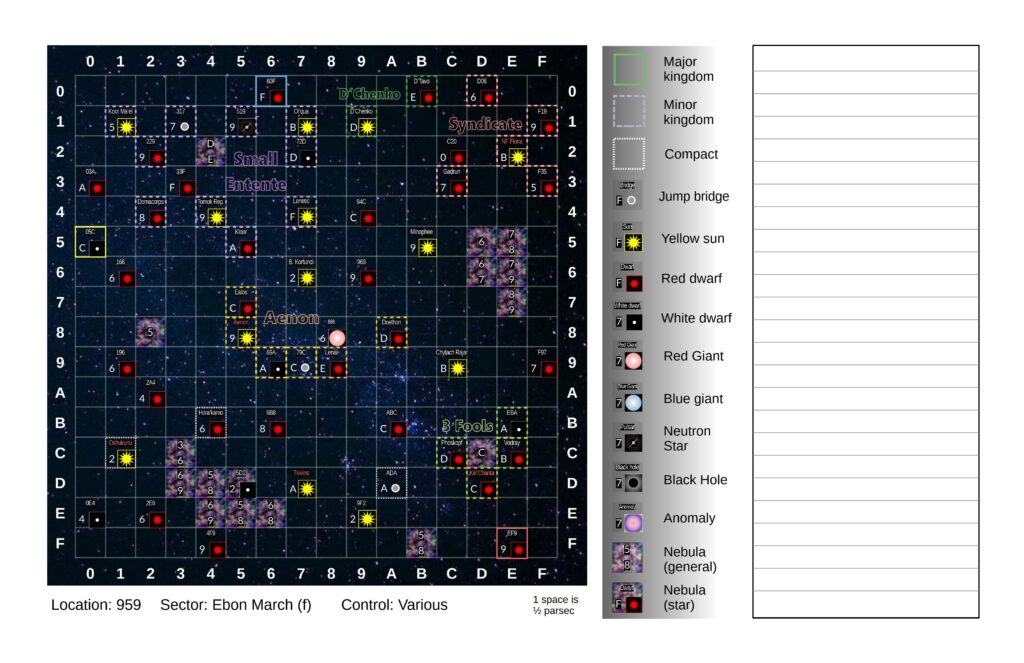“If you’ve been to a Compact office in all eight Core sectors, you qualify for preferred status at Compact customs and inspection stations.”
Compact-approved TAS guide.

Traveller has traditionally relied on a 2D map for Charted Space, but we are using our own setting, so we went our own way, with a 3D map, and with no Earth for reference.
Close distances (within a system) are in standard units of meters, gleaned by numerous cultures across the Array from artifact tablets. No one knows what these units are based on originally.
At the interstellar level, distances are in parsecs, and two scales of map are used: the full Array map, and sector maps.
Array Map

On the full map are 4096 sectors, each with their x, y and z coordinates from 0 to 15. In Traveller tradition, we use hexadecimal, where the numbers above 9 are the letters A through F, for a range of 0 to F. Thus, a sector’s location is a three digit number (49A for example).
The Array map has 16 levels, (0 to F), each representing a z coordinate. They are arranged in a spiral, with the top-most in the upper left, and the bottom-most at the center. A red line shows the flow of the spiral. The levels are considered to be stacked, one atop the next, so that two sectors with the same x and y coordinates are adjacent if their z coordinates differ by one.
The map uses traditional directions of north, south, east and west, and adds the vertical directions of high (closer to the top) and deep (closer to the bottom). The interstellar culture uses depth as the standard in the Array, so the greater the z number, the deeper you go in the Array. There are also some sectors just off of the full map, but by far the majority of stars are on the Array map.
Major kingdoms are marked on the Array map. We’ll update the Array map from time to time.
Sector Maps

Each sector is 8 parsecs across laterally, divided into 1/2 parsec cubic spaces, so that it’s 16 spaces wide. Each space is a potential location for a system. If a system is present, the z coordinate is in the lower left of the space.
This scale may seem small by traditional Traveller standards, where the spaces would be 1 parsec across, but since the sectors here represent cubic spaces, we want to leave room. A sector is 16 x 16 x 16 spaces, with over 4000 potential locations, and two stars may appear near to each other, yet have disparate z coordinates.
Due to the scale, jump ratings are multiplied by 2 to get the range on the sector map. This means there can be fractional jump ratings (a jump-3.5 drive has range of 7).
Like the Array map, a space can be designated with three hexadecimal digits (5BE for example). Thus, to designate the location of a star system in the Array, you can use a six digit number, where the first three are the sector, and the last three are the space within the sector (53A2B6 for example).
Unlike the Array map, which we only needed to print once on a larger sheet, sectors are intended to print out on as small a sheet as needed and bring to the game physically. To make this possible, we have made the decision that on a sector map, no two systems can share the same x and y coordinates. This means no system can be directly above another in the same sector. It’s our concession to the gods of 2D.
Nebulae are spaces on a sector map. If a system is known to exist within, then the nebula is ‘collapsed’ down to one space, including the z, but if no systems are known to exist, the x/y space on the map is over a range of z coordinates. Jumping into or out of a nebula space is a bane on jump rolls (disadvantage). Jumping into our out of an empty space (with no significant mass for calibration) is also a bane, and these stack. For each nebula space passed through in a jump, subtract one from the jump roll. Big nebulae can be serious obstacles.
Distance
The sector maps use Pythagorean distance. To find the distance between two systems, find the difference along each dimension, x, y and z. Square each, then add them together. The square root of the result is the distance (round up).
For example, if you’re in a system at 3A6, and you want to know the distance to another system at 66B, you would first find the difference along each dimension. That’s 3 along the x axis, 4 along the y axis, and 5 along the z axis. 3² + 4² + 5² = 9 + 16 + 25 = 50. The square root of 50 is just barely over 7, but you always round up, so the distance is 8. You’d need jump-4 to traverse it in one jump.
When moving from a system in one sector to a system in another, it’s still straightforward to determine the difference along each dimension, to find the range in spaces.
One note on the math: it’s not more advanced than that used in the MGT2E rules on travel times, and fans of the genre generally know what a square root is.
Systems
Here we’re relying on straight-up Traveller, mainly MGT2E, with the world hex system from T5 for key worlds. The stars on a sector map are visible, and can be categorized fairly easily. The contents of a system aren’t as easily knowable. For characters searching in the game, the entries if any for planets in their databases will use UWPs, but the info available to travellers may be dated, or confusing, or even just plain wrong. The star systems, planets and kingdoms will get ‘Array-opedia’ entries as they are created.

